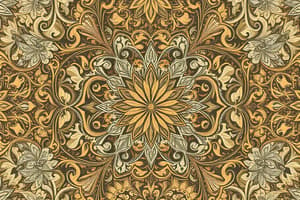Podcast
Questions and Answers
What is the Fibonacci sequence?
What is the Fibonacci sequence?
- A sequence of numbers where each number is the sum of the two preceding ones (correct)
- A sequence of prime numbers found in nature
- A sequence of numbers where each number is a multiple of the preceding one
- A sequence of numbers where each number is a power of the preceding one
What is the Liber Abbaci?
What is the Liber Abbaci?
- A collection of poetry by Leonardo of Pisa
- An arithmetic text on financial computations and the promotion of Hindu-Arabic numerals (correct)
- A philosophical treatise on patterns in nature
- A historical account of Pisa, Italy
What is the significance of the Fibonacci sequence in nature?
What is the significance of the Fibonacci sequence in nature?
- It appears in various biological settings, such as the branching of trees and arrangement of leaves on a stem (correct)
- It determines the cycle of the seasons
- It governs the movement of stars in the sky
- It is a sequence commonly used in weather prediction models
What is the primary function of mathematics in relation to patterns in nature?
What is the primary function of mathematics in relation to patterns in nature?
Who was Leonardo of Pisa's father and what was his profession?
Who was Leonardo of Pisa's father and what was his profession?
Flashcards are hidden until you start studying
Study Notes
Fibonacci Sequence and Liber Abbaci
- The Fibonacci sequence is a series of numbers in which each number is the sum of the two preceding numbers: 0, 1, 1, 2, 3, 5, 8, 13, ...
- The Liber Abbaci, written by Leonardo of Pisa, is a book that introduced the Fibonacci sequence to Europe and popularized the Hindu-Arabic numeral system.
Significance in Nature
- The Fibonacci sequence appears in various patterns in nature, such as:
- Branching of trees
- Phyllotaxis (arrangement of leaves on stems)
- Floral arrangements
- Shapes of seashells
- The sequence is observed in the growth patterns of many living organisms, demonstrating the mathematical basis of natural patterns.
Mathematics and Nature
- Mathematics serves as a tool to understand and describe patterns in nature, enabling us to identify and analyze these patterns.
- Mathematical concepts, like the Fibonacci sequence, help us recognize and comprehend the underlying order in natural systems.
Leonardo of Pisa
- Leonardo of Pisa, also known as Fibonacci, was an Italian mathematician who introduced the Hindu-Arabic numeral system to Europe.
- His father, Guglielmo Bonacci, was a Pisan merchant and a customs officer.
Studying That Suits You
Use AI to generate personalized quizzes and flashcards to suit your learning preferences.




